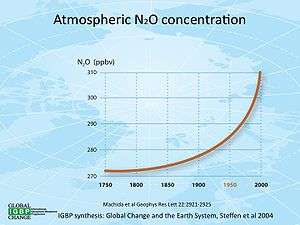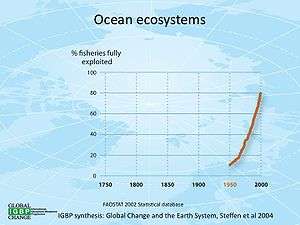Global change



















Global change refers to planetary-scale changes in the Earth system. The system consists of the land, oceans, atmosphere, polar regions, life, the planet’s natural cycles and deep Earth processes. These constituent parts influence one another. The Earth system now includes human society, so global change also refers to large-scale changes in society.[1]
More completely, the term “global change” encompasses: population, climate, the economy, resource use, energy development, transport, communication, land use and land cover, urbanization, globalization, atmospheric circulation, ocean circulation, the carbon cycle, the nitrogen cycle, the water cycle and other cycles, sea ice loss, sea-level rise, food webs, biological diversity, pollution, health, over fishing, and more.[2]
History of global-change research
In 1980, a group of scientists led by Swedish meteorologist Bert Bolin set up an international program called the World Climate Research Programme (WCRP), to determine whether the climate was changing, whether climate could be predicted and whether humans were in some way responsible for the change. The programme was sponsored by the World Meteorological Organization and the International Council for Science (ICSU). As time went on, there was a growing realisation that climate change was one part of a larger phenomenon, global change. In 1987, a team of researchers, led again by Bert Bolin, James McCarthy, Paul Crutzen, H. Oeschger and others, successfully argued for an international research programme to investigate global change. This programme, sponsored by ICSU, is the International Geosphere-Biosphere Programme (IGBP). The programme has eight projects investigating different parts of the Earth system and links between them.
IGBP, WCRP and a third programme, the International Human Dimensions Programme (IHDP, founded in 1996), spearheaded a landmark science conference held in Amsterdam in 2001. The conference, Challenges of a Changing Earth: Global Change Open Science Conference, led to the Amsterdam Declaration which stated, “In addition to the threat of significant climate change, there is growing concern over the ever-increasing human modification of other aspects of the global environment and the consequent implications for human well-being. Basic goods and services supplied by the planetary life support system, such as food, water, clean air and an environment conducive to human health, are being affected increasingly by global change.”[3]
The declaration goes on to say, “The international global change programmes urge governments, public and private institutions and people of the world to agree that an ethical framework for global stewardship and strategies for Earth System management are urgently needed.”[3]
Many nations now have their own global change programmes and institutes, for example the US Global Change Research Program and the UK’s Quantifying and Understanding the Earth System (QUEST) programme. And since the Amsterdam conference another international programme focusing on biodiversity has been set up, DIVERSITAS. These programmes form the Earth System Science Partnership.
In 2012, these international programmes held another major science conference in London, Planet Under Pressure: new knowledge towards solutions.
Causes of global change
In the past, the main drivers of global change have been solar variation, plate tectonics, volcanism, proliferation and abatement of life, meteorite impact, resource depletion, changes in Earth’s orbit around the sun and changes in the tilt of Earth on its axis. There is overwhelming evidence that now the main driver of planetary-scale change, or global change, is the growing human population’s demand for energy, food, goods, services and information, and its disposal of its waste products. In the last 250 years, global change has caused climate change, widespread species extinctions, fish-stock collapse, desertification, ocean acidification, ozone depletion, pollution, and other large-scale shifts.
Scientists working on the International Geosphere-Biosphere Programme have said that Earth is now operating in a “no analogue” state.[4] Measurements of Earth system processes, past and present, have led to the conclusion that the planet has moved well outside the range of natural variability in the last half million years at least. Homo sapiens have been around for about 200,000 years.
What this means for the planet and society remains unclear. But, in the last 20 years there has been an enormous international research effort to understand global change and the Earth system. An aim of this research is to work out if there are planetary boundaries and are we approaching them. Scientists, international governmental organizations and lobbying organizations like World Wide Fund for Nature argue that current consumption levels, particularly in developed countries, are not sustainable because there is a very real danger they will push the planet into a new state. What this new state might look like is still being debated, but sea levels are likely to rise several meters, the pH of the oceans, a measure of its acidity, is likely to drop farther than it has in 20 million years, and global atmospheric and ocean circulations may shift markedly. The major cycles – carbon, nitrogen, sulfur, phosphorus, water – and other important parameters would alter, bringing drought to some places, floods to others. Governments will no longer be able to take for granted the relative environmental stability that has allowed human society to flourish and led to rapid globalization. Most of the population of the planet will be affected. The re-insurance industry is already taking measures to protect its interests and maximize profits as turbulent times approach.
Physical evidence for global change
Humans have always altered their environment. The advent of agriculture around 10000 years ago led to a radical change in land use that still continues. But, the relatively small human population had little impact on a global scale until the start of the industrial revolution in 1750. This event, followed by the invention of the Haber-Bosch process in 1909, which allowed large-scale manufacture of fertilizers, led directly to rapid changes to many of the planet’s most important physical, chemical and biological processes.
The 1950s marked a shift in gear: global change began accelerating. Between 1950 and 2010, the population more than doubled. In that time, rapid expansion of international trade coupled with upsurges in capital flows and new technologies, particularly information and communication technologies, led to national economies becoming more fully integrated. There was a tenfold increase in economic activity and the world’s human population became more tightly connected than ever before. The period saw sixfold increases in water use and river damming. About 70 percent of the world’s freshwater resource is now used for agriculture. This rises to 90 percent in India and China. Half of the Earth’s land surface had now been domesticated. By 2010, urban population, for the first time, exceeded rural population. And there has been a fivefold increase in fertilizer use. Indeed, manufactured reactive nitrogen from fertilizer production and industry now exceeds global terrestrial production of reactive nitrogen. Without artificial fertilizers there would not be enough food to sustain a population of seven billion people.
These changes to the human sub-system have a direct influence on all components of the Earth system. The chemical composition of the atmosphere has changed significantly. Concentrations of important greenhouse gases, carbon dioxide, methane and nitrous oxide are rising fast. Over Antarctica a large hole in the ozone layer appeared. Fisheries collapsed: most of the world’s fisheries are now fully or over-exploited. Thirty percent of tropical rainforests disappeared.
In 2000, Nobel prize-winning scientist Paul Crutzen announced the scale of change is so great that in just 250 years, human society has pushed the planet into a new geological era: the Anthropocene. This name has stuck and there are calls for the Anthropocene to be adopted officially. If it is, it may be the shortest of all geological eras. Evidence suggests that if human activities continue to change components of the Earth system, which are all interlinked, this could heave the Earth system out of a one state and into a new state.
Global change and society
Global change in a societal context encompasses social, cultural, technological, political, economic and legal change. Terms closely related to global change and society are globalization and global integration. Globalization began with long-distance trade and urbanism. The first record of long distance trading routes is in the third millennium BC. Sumerians in Mesopotamia traded with settlers in the Indus Valley, in modern-day India.
Since 1750, but more significantly, since the 1950s, global integration has accelerated. This era has witnessed incredible global changes in communications, transportation, and computer technology. Ideas, cultures, people, goods, services and money move around the planet with ease. This new global interconnectedness and free flow of information has radically altered notions of other cultures, conflicts, religions and taboos. Now, social movements can and do form at a planetary scale.
Evidence, if more were needed, of the link between social and environmental global change came with the 2008-2009 global financial crisis. The crisis pushed the planet’s main economic powerhouses, the United States, Europe and much of Asia into recession. According to the Global Carbon Project, global atmospheric emissions of carbon dioxide fell from an annual growth rate of around 3.4% between 2000 and 2008, to a growth rate of about 2% in 2008.[5]
Planetary management
Humans are altering the planet’s biogeochemical cycles in a largely unregulated way with limited knowledge of the consequences.[4] Without steps to effectively manage the Earth system – the planet’s physical, chemical, biological and social components – it is likely there will be severe impacts on people and ecosystems. Perhaps the largest concern is that a component of the Earth system, for example, an ocean circulation, the Amazon rainforest, or Arctic sea ice, will reach a tipping point and flip from its current state to another state: flowing to not flowing, rainforest to savanna, or ice to no ice. A domino effect could ensue with other components of the Earth system changing state rapidly.
Intensive research over the last 20 years has shown that tipping points do exist in the Earth system, and wide-scale change can be rapid – a matter of decades. Potential tipping points have been identified and attempts have been made to quantify thresholds. But to date, the best efforts can only identify loosely defined "planetary boundaries" beyond which tipping points exist but their precise locations remain elusive.
There have been calls for a better way to manage the environment on a planetary scale, sometimes referred to as managing “Earth’s life support system”. The United Nations was formed to stop wars and provide a platform for dialogue between countries. It was not created to avoid major environmental catastrophe on regional or global scales. But several international environmental conventions exist under the UN, including the Framework Convention on Climate Change, Montreal Protocol, Convention to Combat Desertification, and Convention on Biological Diversity. Additionally, the UN has two bodies charged with coordinating environmental and development activities, the United Nations Environment Programme (UNEP) and the United Nations Development Programme (UNDP).
In 2004, the IGBP published “Global Change and the Earth System, a planet under pressure.”[4] The publication’s executive summary concluded: “An overall, comprehensive, internally consistent strategy for stewardship of the Earth system is required”. It stated that a research goal is to define and maintain a stable equilibrium in the global environment.
In 2007, France called for UNEP to be replaced by a new and more powerful organization called the “United Nations Environment Organization”. The rationale was that UNEP’s status as a “programme”, rather than an “organization” in the tradition of the World Health Organization or the World Meteorological Organization, weakened it to the extent that it was no longer fit for purpose given current knowledge of the state of the planet.
See also
- Biogeochemistry
- Climate change
- Earth system science
- Ozone depletion
- Sustainability
- Tipping point (climatology)
References
- ↑ "International Geosphere-Biosphere Programme the Earth as a System". Archived from the original on 2010-04-29. Retrieved 2010-03-25. International Geosphere-Biosphere Programme
- ↑ "The Achilles Heel of the Earth System" (PDF). International Institute for Applied Systems Analysis. Retrieved 2010-03-25.
- 1 2 "The Amsterdam Declaration". Earth System Science Partnership. Retrieved 2010-03-25.
- 1 2 3 "Global Change and the Earth System". Retrieved 2010-03-25.
- ↑ "2008 Global Carbon Budget". Global Carbon Project. Retrieved 2010-03-25.